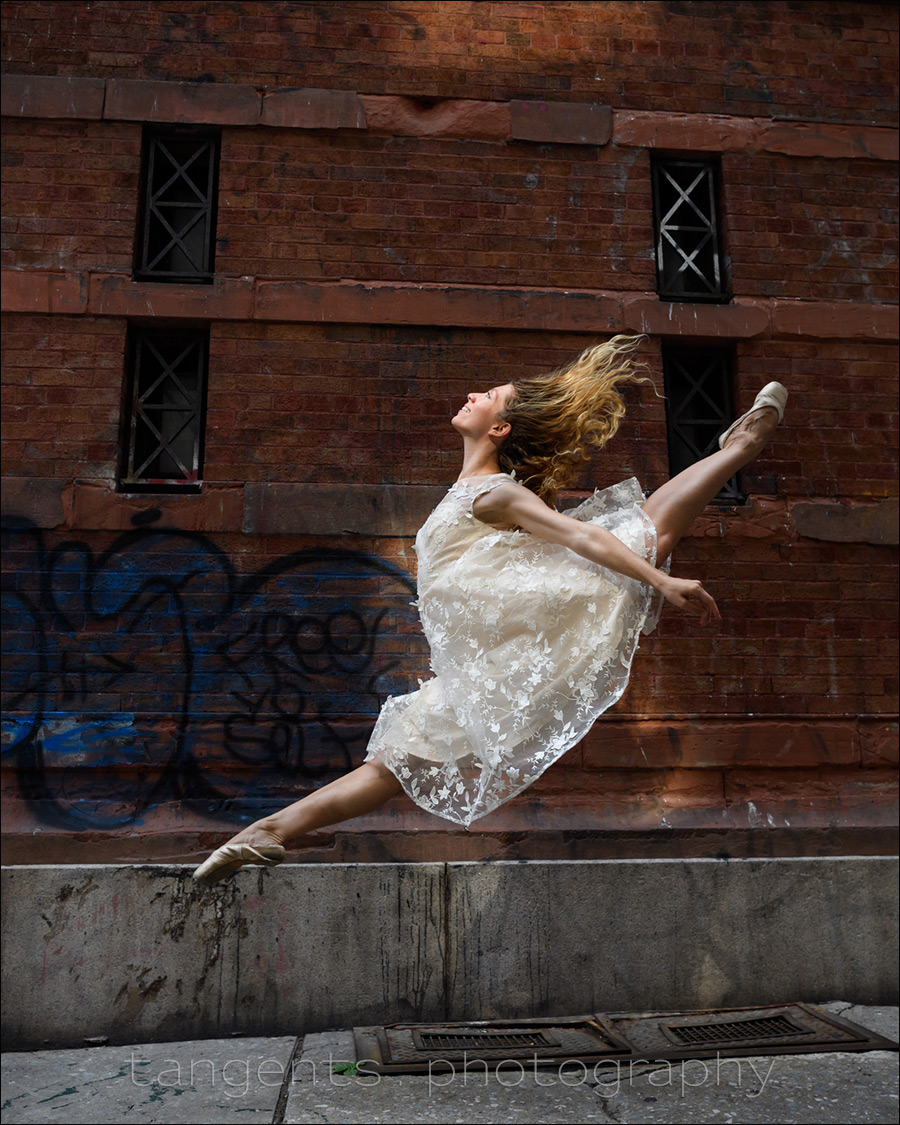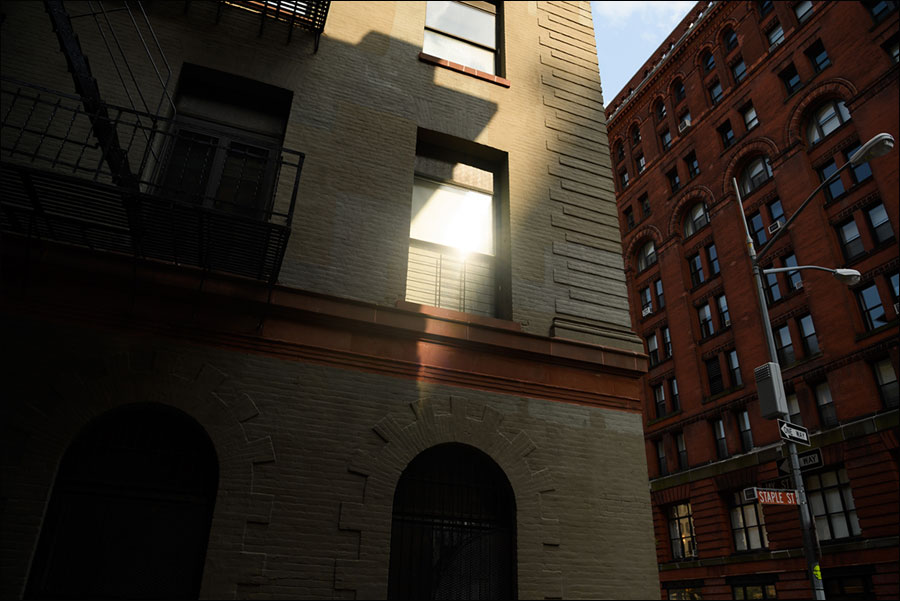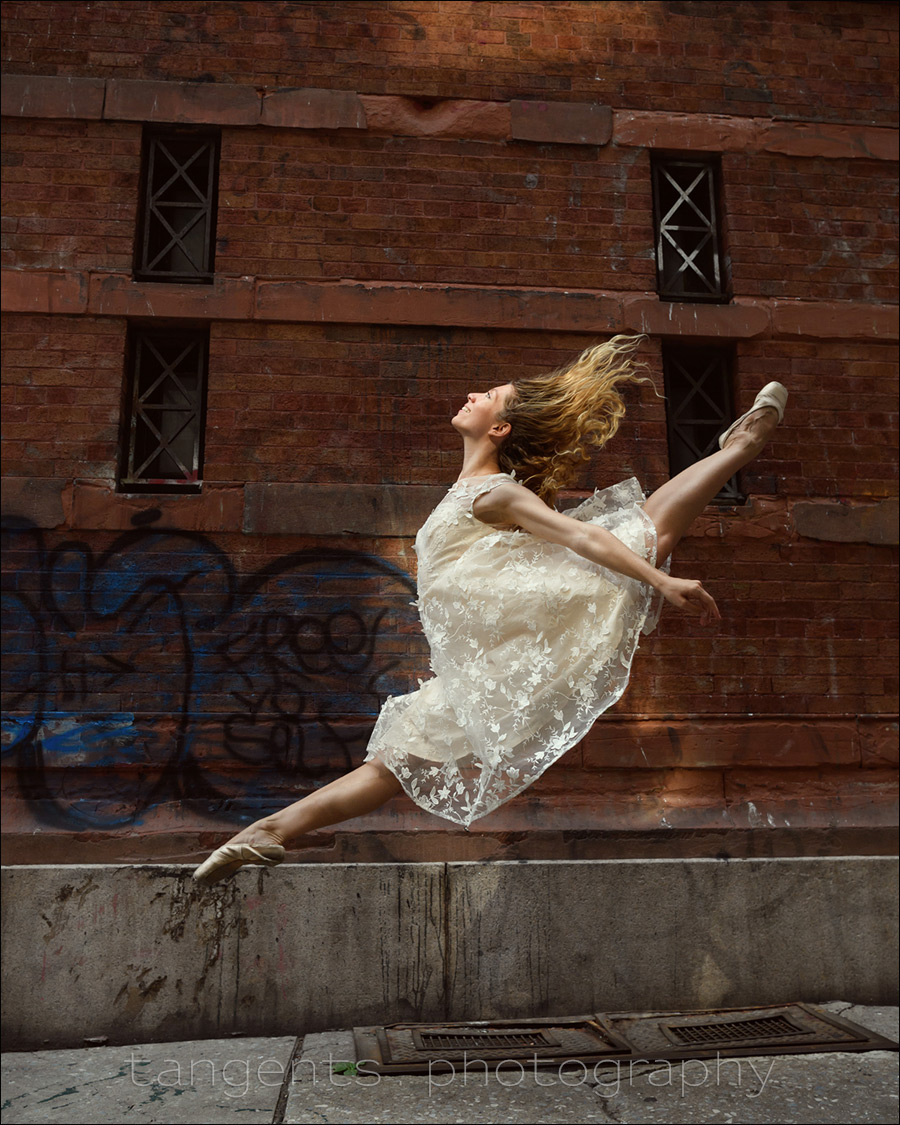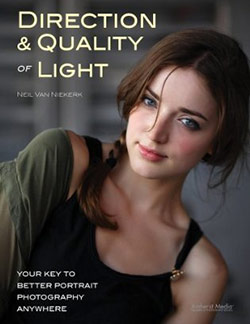
Photographing with available light only
While photographing dancer, Anna Russell, in this side-street in New York, I noticed those splashes of light against the wall. These little pools of light were from sunlight reflecting off nearby windows. I wanted to see if we could have Anna hit one of those in mid-air. What also helped was the general direction of light in this area – it mostly came from the main road to the left of the frame, since we were shooting in a narrow street with tall buildings.
The main splash of light on her was sunlight reflecting off this window of a building opposite to where we were working:

This meant that Anna was facing towards the main source of available light — and it made sense to photograph her leaping in that direction. A simple, obvious choice. And then, those random splashes of light to brighten the scene.
- 1/1250 @ f/4 @ 1000 ISO
- Nikon D5 with the Nikon 24-70mm f/2.8E VR
Obviously the higher ISO was to force a faster shutter speed to freeze her movement.
I played a bit with this image by adding a color grading effect to slightly warm it up, and reduce the contrast. But as so often happens when I explore Photoshop effects, I dialed it down until it was so close to the original to render the added effect trivial. The images I shoot generally look pretty good out of the RAW converter. My RAW defaults are set to punch up the basic image a bit already, because I adjusted my RAW defaults to give me a basic image that I already like.
Here is the effect which I liked … but then discarded in favor of the basic image which already looked good to my eye.
With available light only
Here is a rambling train of thought that was triggered a discussion recently on FB. I saw a lovely portrait photograph (in a FB group), and the photographer offered that it was “available light only”. This caught my attention because it didn’t look like it was only availably light – I was convinced that a fair amount of Photoshop work went into creating that portrait. My feelings are that you can not boast how a photo is “natural light only”, when you juice it up with (let me quote from that example), “Frequency Separation; dodge and burn and gradient maps in Photoshop”. That’s a truckload of Photoshopping which belies the ethos of it being only natural light.
I have to mention that I am in awe of Photoshop wizardry. Just don’t call it “natural light only.” Also, this isn’t a rant about photographers using available light – the same goes for people who show amazing photos using off-camera lighting, and in mentioning the lighting setup, don’t acknowledge the amount of post-production that went into the look.
The editing, regardless of natural or artificial, can be misleading to new photographers when it isn’t mentioned upfront as part of creating a specific look.
Please note again, this isn’t an “available light vs additional lighting” discussion. I do believe that the stronger photographers can easily utilize either option, and still keep it to a coherent style. That is essential!
My friend Ulysses more eloquently elaborated on the dilemma:
The problem comes in when you’re trying to make purchase decisions on lights and light modifiers, you can’t completely trust a lot of the FB and IG samples because the results they often show are inherently deceiving — not necessarily purposeful. You just need to understand what you’re looking at.
I love natural light. I love strobes and auxiliary lighting. I love not touching a well-put-together photo. I love going nuts with filters and styles on other photos. I admire photographers who excel at minimalism when it comes to not needing to heavily process their photos (like so many Nat Geo photographers). I admire craftsmen who know the ins and outs of Photoshop tools to a degree that I will never achieve. What I do NOT love is the way photographers can get really frustrated with their tools and with their photography because they don’t understand why they’re not getting the results they want. This happens partly because the system is a little bit rigged against them. Again, not always on purpose (but sometimes on purpose).
The context here is interesting because I’ve been fielding a lot of comments from photographers new to the Godox lights and to the wide choices of modifiers available. I keep getting shown all these sample photos with comments like “I want my photos to look like this. If I buy modifier XYZ, how can I make my photos look like this during my kids’ holiday vacation?”
Answer: Your photos ain’t gonna look like that during the holiday vacation.
The cautionary word here then is to not be misled about the results that can be achieved with a specific light modifier … or with natural light only. There might very well be much more to it.
With additional lighting I have more control, and (can) spend less time in post-production because I already control the contrast and tones to a large extent while shooting. With available light only, you have to get more lucky more often … or spend time in Photoshop.
How this relates to my work in general, and specifically the tutorials on the Tangents blog – my images here tend to have minimal Photoshop work aside from mild skin retouching. For me, it is important that I show the results (nearly) straight out of camera, or at least, straight out of the RAW converter. It just wouldn’t be truthful to have lighting tutorials which rely too heavily on Photoshop for the specific look.
Direction & Quality of Light
I wanted to distill the essence of what we, as photographers, work with – light! Before we can truly grasp on-camera flash and off-camera flash, and really, any kind of photography, we have to be aware of the direction and quality of light. We need to observe the light that we have, and then decide how best to use it, or enhance it.
With this book, I try my best to share those “aha!” moments with you, and I do believe this book can make a difference to your photography.
The book is available on Amazon USA and Amazon UK, or can be ordered through Barnes & Nobles and other bookstores. The book is also available on the Apple iBook Store, as well as Amazon Kindle.
Related articles
- Available light portraits (model: Nicole)
- Available light portrait photography (model: Anastasiya)
- Photography: Using light fall-off to illuminate your subject
- Available light portraits – Composition, light and style (model: Christy)
- Using interesting available light & White Balance options (model: Olena)
- Available light: Boudoir photography & Feminine portraiture (model: Adrienne)
Finally
Let us know what your take is on this? I’d love to hear.


That’s a thought that had been at the back of my mind when I see images online…most had been post-processed either by Photoshop, or more recently by those one-click auto enhancer phone apps, that I felt they were not the simple images the photographers implied them to be
And yes, those labelled “natural light only” amused me when the final images were obviously derivative works after being Photoshopped
It’s interesting that our preferences can be influenced over time
I prefer images which were not obviously post-processed; I noticed younger people preferred what I felt were overly processed images. Like the color-graded fad we see nowadays
I learned the benefits of good focus, exposure, and saturation…these were turned on their heads when I see people liking images that are obviously out of focus, over- or under-exposed, and color-graded to blatantly artificial colors
Then there are the HDRs
Each person has his/her own opinion and standard of beauty, I guess
BTW, I prefer your original image as I think the processed image is a little too warm
Great article, seems like more time is now spent in photoshop then taking the actual photos. A lot of photos online look so overdone.
One of the concerns is this whole ‘natural light’ think sprang up, for me at least, in the wedding and sometimes family portrait world. It was an attempted differentiator by some photographers, implying that their work was somehow more organic and by extension … better. And the photographers claiming that supposed purity for themselves often didn’t know how to light and were doing their clients a disservice. (At least in some northern markets where we have clouds and rain sometimes.) So I reacted negatively to anyone pitching themselves this way. And to this term. It represented a challenge in terms of repeatability and service to a largely consumer market who just wanted nice pictures of their kids next week or of their wedding on a non-negotiable already scheduled date. When the light might be nothing like what the portfolio samples show …
I shoot natural light or as we used to call it available light. I modify, tweak, sculpt … then when all of those tools either don’t work or aren’t available (hah, a pun!), then I move to the next tool or skill at my disposal. That may involve reflectors, a small strobe, lots of small strobes or differing amounts of high power strobes. Heck in one recent shoot it involved discarded bags from animal feed that happened to be white. Scattered everywhere. Beautiful natural bounce fill!
Perhaps if these photographers started explaining that they used natural light as the photographic base material for the image they were creating.
What matters is what you see and what you intend to create. And how well you translate that vision into a fixed image and how well it resonates with your intended audience.
Maybe I’ll start marketing myself as a fully-manual photographer. Spent the first couple of decades of my career as one so maybe I can bring it back as a “style”.
This is a pretty interesting topic for me especially this year, where I have grown weary of the frequency separation, the “filters” and other phone gimmickry in relation to image-making. I have respect for retouchers and have worked with them for commercial clients. I just feel strongly that we are trying to achieve “ideals” that are far removed from reality. I do not want my daughter growing up and thinking that true beauty is perfect zero-acne, perfectly textured, near-geometrically placed skin pored skin.
I have thus been shooting natural light portraits this summer. Unretouched. I do minimal post, perhaps a B&W conversion, a contrast tweak or similar.
I do know how to use supplemental lighting and I am pretty decent at Photoshop but I feel like I want to go back to “basics”… So if I shoot natural light, it defeats the purpose if I then spend ages in PS after the fact, “resculpting” the light…
Neil,
How do I make the adjustments you stated below:
My RAW defaults are set to punch up the basic image a bit already, because I adjusted my RAW defaults to give me a basic image that I already like.
Thanks Jerry
Hi there Jerry – just for you: here is how I adjust the default of RAW images. The examples I used there are for Sony, but I use similar settings for my other non-Sony cameras.